
Funk is a music genre that originated in African-American communities in the mid-1960s when musicians created a rhythmic, danceable new form of music through a mixture of various music genres that were popular among African-Americans in the mid-20th century. It deemphasizes melody and chord progressions and focuses on a strong rhythmic groove of a bassline played by an electric bassist and a drum part played by a percussionist, often at slower tempos than other popular music. Funk typically consists of a complex percussive groove with rhythm instruments playing interlocking grooves that create a "hypnotic" and "danceable" feel. It uses the same richly colored extended chords found in bebop jazz, such as minor chords with added sevenths and elevenths, and dominant seventh chords with altered ninths and thirteenths.
In music, an ostinato is a motif or phrase that persistently repeats in the same musical voice, frequently in the same pitch. Well-known ostinato-based pieces include classical compositions such as Ravel's Boléro and the Carol of the Bells, and popular songs such as Donna Summer and Giorgio Moroder's "I Feel Love" (1977), Henry Mancini's theme from Peter Gunn (1959), The Who's "Baba O'Riley" (1971), The Verve's "Bitter Sweet Symphony" (1997), and Flo Rida's "Low" (2007).

Jazz fusion is a popular music genre that developed in the late 1960s when musicians combined jazz harmony and improvisation with rock music, funk, and rhythm and blues. Electric guitars, amplifiers, and keyboards that were popular in rock and roll started to be used by jazz musicians, particularly those who had grown up listening to rock and roll.

In music, groove is the sense of an effect ("feel") of changing pattern in a propulsive rhythm or sense of "swing". In jazz, it can be felt as a quality of persistently repeated rhythmic units, created by the interaction of the music played by a band's rhythm section. Groove is a significant feature of popular music, and can be found in many genres, including salsa, rock, soul, funk, and fusion.
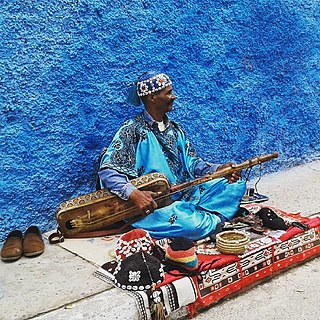
The Gnawa are an ethnic group inhabiting Morocco, that had been brought as slaves from West African Sahel, especially northern Nigeria.
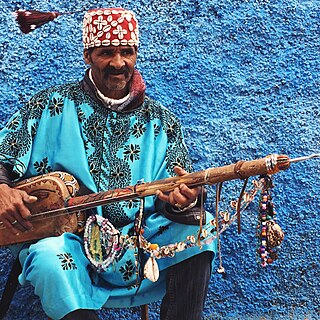
Gnawa music is a body of Moroccan religious songs and rhythms. Its well-preserved heritage combines ritual poetry with traditional music and dancing. The music is performed at lila, communal nights of celebration dedicated to prayer and healing guided by the Gnawa maalem, or master musician, and their group of musicians and dancers. Though many of the influences that formed this music can be traced to West African kingdoms, its traditional practice is concentrated in Morocco. Gnawa music has spread to many other countries in Africa and Europe, such as France.
Afro rock is a style of rock music with African influences. Afro rock is a dynamic interplay between Western rock music and African musical elements such as rhythm, melodies and instrumentation. Afro rock bands and artists in the late 1960s and early 1970s included Osibisa, Assagai and Lafayette Afro Rock Band.
Ethno jazz, also known as world jazz, is a subgenre of jazz and world music, developed internationally in the 1950s and '60s and broadly characterized by a combination of traditional jazz and non-Western musical elements. Though occasionally equaled to or considered the successor of world music, an independent meaning of ethno jazz emerged around 1990 through the commercial success of ethnic music via globalization, which especially observed a Western focus on Asian musical interpretations. The origin of ethno jazz has widely been credited to saxophonist John Coltrane.
Nass Marrakesh is a Gnawa music group formed in 1991. They introduced instruments foreign to Gnawa music such as the djembe, tam-tam, mandolin, tabla and Afro-Cuban percussion.

Friday Afternoon in the Universe is an album by the experimental jazz fusion trio Medeski Martin & Wood. The album title is taken from the opening sentence of "Old Angel Midnight", by Jack Kerouac.

Hassan Hakmoun is a Moroccan musician who specializes in the Gnawa style.
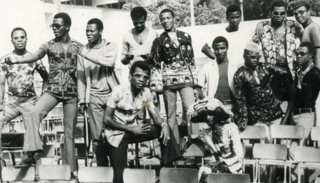
Orchestre Poly-Rythmo de Cotonou is a band from Cotonou, Benin, originally active from the 1960s to the 1980s and founded by singer-guitarist Mélomé Clément. They reformed in 2009 to international recognition. Their work has mixed styles such as funk, afrobeat, psychedelia, jazz and local voodoo influences. The Guardian called them "one of West Africa's best dance bands."

Aziz Sahmaoui is a Moroccan musician specialized in the modern Gnawa music.
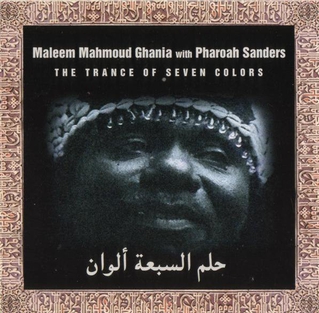
The Trance of Seven Colors is an album by Gnawa musician Maleem Mahmoud Ghania released by Axiom and Island Records in 1994. The music, which was recorded on June 1–3, 1994 at the house of the Caid Khoubane in the Medina of Essaouira, District Chbanat, Morocco, also features tenor saxophonist Pharoah Sanders, along with a group largely consisting of members of Mahmoud's family.
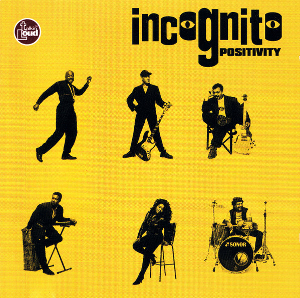
Positivity is an album by the British band Incognito, released in 1993. The band supported the album with a North American tour.
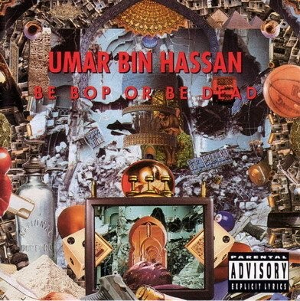
Be Bop or Be Dead is the debut solo album by the American musician and Last Poet Umar Bin Hassan, released in 1993. Hassan had spent many of the preceding years isolated from his group and his music while dealing with drug and personal issues. The album was a commercial disappointment.
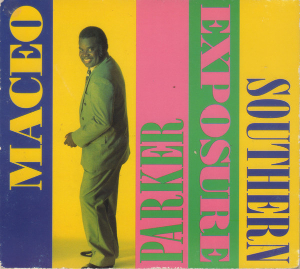
Southern Exposure is an album by the American musician Maceo Parker. It was released in 1993. Although marketed as a jazz album, Parker considered it to be "98%" funk.

Simultonality is a 2017 album by multi-instrumentalist and composer Joshua Abrams and the Natural Information Society.














